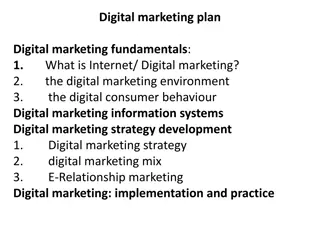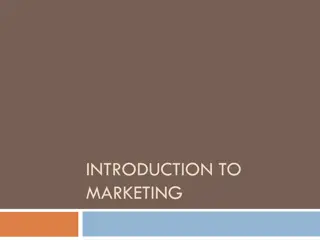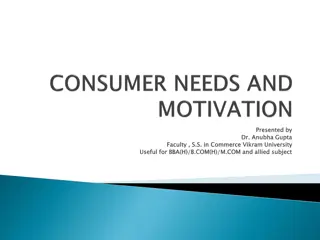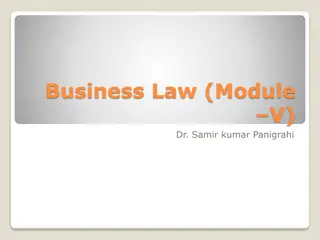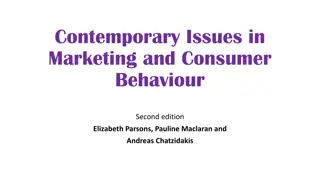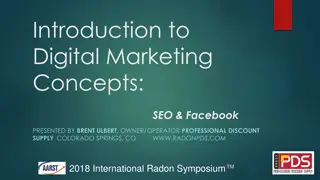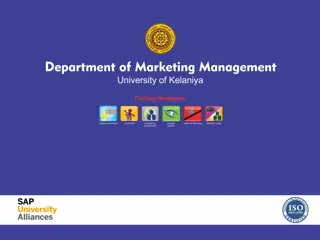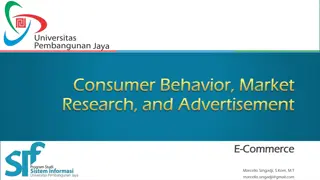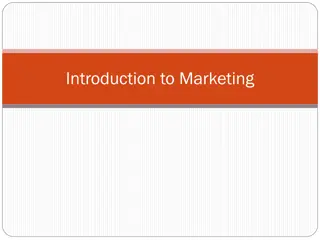Understanding Consumer Behavior in Marketing
Consumers are influenced by various internal and external factors when making purchasing decisions. Marketers need to understand consumer behavior to effectively meet their needs and wants. Consumer Behavior is a crucial interdisciplinary subject for firms to succeed in today's competitive market.
Download Presentation

Please find below an Image/Link to download the presentation.
The content on the website is provided AS IS for your information and personal use only. It may not be sold, licensed, or shared on other websites without obtaining consent from the author. Download presentation by click this link. If you encounter any issues during the download, it is possible that the publisher has removed the file from their server.
E N D
Presentation Transcript
Consumer Behaviour 6thSemester IMBA Maleeha Gul
Introduction We are all consumers. We buy groceries, computers, and cars. We purchase services ranging from bank accounts to college educations. However, we also know that consumers are different from one another. We buy different clothes, drive different cars, and eat different foods. Moreover, even the same consumer can make different decisions depending on the situation. So how are we to construct coherent marketing strategies? In this class we will examine how and why consumers behave the way that they do. We will explore our intuitions about our own behavior. We will learn about theories developed in marketing, psychology, and other behavioral sciences. And we will learn how to use these theories to predict how consumers will respond to different marketing activities.
Understanding the consumer What we buy, how we buy, where and when we buy, in how much quantity we buy depends on our perception, self concept, social and cultural background and our age and family cycle, our attitudes, beliefs values, motivation, personality, social class and many other factors that are both internal and external to us. While buying, we also consider whether to buy or not to buy and, from which source or seller to buy. In some societies there is a lot of affluence and, these societies can afford to buy in greater quantities and at shorter intervals. In poor societies, the consumer can barely meet his barest needs. The marketers therefore tries to understand the needs of different consumers and having understood his different behaviours which require an in-depth study of their internal and external environment, they formulate their plans for marketing.
Why study CB The marketer helps satisfy needs and wants through product and service offerings. For a firm to survive, compete and grow, it is essential that the marketer identifies these needs and wants, and provides product offerings more effectively and efficiently than other competitors. A comprehensive yet meticulous knowledge of consumers and their consumption behavior is essential for a firm to succeed. Herein, lies the essence of Consumer Behavior, an interdisciplinary subject, that emerged as a separate field of study in the 1960s.
Why the field of CB developed: In order to succeed in any business, and especially in today s dynamic & rapidly evolving market place, marketers need to know everything they can about consumers what they want, what they think, how they work, how they spend their leisure time. The field of CB is rooted in the Marketing concept. Production concept Product concept Selling Concept Marketing concept- CB developed from this concept. Here everything is executed from the point of view of Consumer.
Emergence of CB Consumer behaviour in management is a very young discipline. Various scholars and academicians concentrated on it at a much later stage. It was during the 1950s, that marketing concept developed, and thus the need to study the behaviour of consumers was recognised. Marketing starts with the needs of the customer and ends with his satisfaction. When every thing revolves round the customer, then the study of consumer behaviour becomes a necessity. Consumer behaviour can be defined as the decision-making process and physical activity involved in acquiring, evaluating, using and disposing of goods and services. This definition clearly brings out that it is not just the buying of goods/services that receives attention in consumer behaviour but, the process starts much before the goods have been acquired or bought. Then follows a process of decision-making for purchase and using the goods, and then the post purchase behaviour which is also very important, because it gives a clue to the marketers whether his product has been a success or not.
Consumer Behaviour As a field of study it is descriptive and also analytical/ interpretive. It is descriptive as it explains consumer decision making and behavior in the context of individual determinants and environmental influences. It is analytical/ interpretive, as against a backdrop of theories borrowed from psychology, sociology, social psychology, anthropology and economics, the study analyzes consumption behavior of individuals alone and in groups. It makes use of qualitative and quantitative tools and techniques for research and analysis, with the objective is to understand and predict consumption behavior. It is a science as well as an art. It uses both, theories borrowed from social sciences to understand consumption behavior, and quantitative and qualitative tools and techniques to predict consumer behavior.
Interdisciplinary Nature Psychology (the study of the individual: individual determinants in buying behavior) Sociology (the study of groups: group dynamics in buying behavior ) Social psychology (the study of how an individual operates in group/groups and its effects on buying behavior) Anthropology (the influence of society on the individual: cultural and cross-cultural issues in buying behavior) Economics (income and purchasing power)
Questions answered To understand the likes and dislikes of the consumer, extensive consumer research studies are being conducted. These researches try to find out: What the consumer thinks of the company s products and those of its competitors? How can the product be improved in their opinion? How the customers use the product? What is the customer s attitude towards the product and its advertising? What is the role of the customer in his family?
Consumer Behaviour Roles Initiator : Initiator is the individual who determines that some need or want is not being fulfilled and authorises a purchase to rectify the situation. Gatekeeper : Influences the family s processing of information. The gatekeeper has the greatest expertise in acquiring and evaluating the information. Influencer : Influencer is a person who, by some intentional or unintentional word or action, influences the buying decision, actual purchase and/or the use of product or service. Decider : The person or persons who actually determine which product or service will be chosen. Buyer : Buyer is an individual who actually makes the purchase transaction. User(s) : User is a person most directly involved in the use or consumption of the purchased product.
Consumer Behaviour Roles Example 1: A child goes to a kindergarten school. She comes back home and asks her parents to buy her a set of color pencils and crayons. Now the roles played are: 1. Initiator: the child in nursery school 2. Influencer: a fellow classmate 3. Decider: the father or the mother 4. Buyer: the father or the mother 5. User: the child Example 2: The lady of a house who is a housewife and spends her day at home doing household chores watches TV in her free time. That is her only source of entertainment. The TV at home is giving problem. She desires a new TV set, and says that she wants an LCD plasma TV. Now the roles played are: 1. Initiator: the housewife (mother) 2. Influencer: a friend / neighbour 3. Decider: the husband or the son 4. Buyer: the husband or the son 5. User: the family
Whom should the marketers target Buyers or Users? Does the decision dependon the type of products? Different household members can perform each of the roles singly or collectively. For example, in deciding which videocassette to rent for entertainment, parents might decide on the movie but children may play a role directly by making their preferences known, or indirectly when parents keep the children s likes in mind. One parent may actually go to the store to get the video, but the entire family may watch it
Development of Marketing Concept Marketing concept evolved in late 1950s and the field of consumer behaviour is deeply rooted in this concept. After World War II, there was great demand for almost all sorts of products and the marketing philosophy was to produce cheap goods and make them available at as many places as possible. This approach suited the marketers because demand exceeded supply and consumers were more interested in obtaining the product rather than in any specific features. This approach is called a production orientation and is based on the assumption that consumers will buy what is available and would not wait for what they really want . The marketer does not really care to know what consumer preferences are.
The next stage has been product orientation, which assumes that consumers will buy the product that offers them the highest quality in terms of performance and features. The company makes all efforts to improve product quality. The focus is on the product rather than on what the consumers need or want. Professor Levitt has called this excessive focus on product quality as marketing myopia. This we see happen in highly competitive markets where some companies keep on adding unnecessary features, passing their cost on to the consumers, in hopes of attracting them.
Selling orientation evolved as a natural consequence of production orientation and product orientation. The marketer is primarily focused on selling the product that it unilaterally decided to produce. The assumption of this approach is that consumers would not buy enough of this product unless they are actively and aggressively persuaded to do so. This approach is known as hard-sell and consumers are induced to buy what they do not want or need. The problem with this approach is that it does not take consumer satisfaction into account. This often leads to dissatisfaction and unhappiness in consumers and is likely to be communicated by word-ofmouth to other potential consumers, discouraging them to buy the product. Soon marketers realised that they could easily sell more goods if they produced only those goods that they had first confirmed consumers would buy. Thus, consumer needs and wants became the marketer s primary focus. This consumer-oriented marketing approach came to be called as the marketing concept. The important assumption underlying marketing concept is that a company must determine the needs and wants of its target markets and deliver the desired satisfactions more efficiently and effectively than the competition. This is the key to successful marketing.
The diversity of CB Human being differs from one to another. It is not easy to predict the human behaviour. Human being differs in their taste, needs, wants and preferences. But one constant thing is that we all are consumers. CB is a vast and complex subject. Understanding CB and knowing consumers are not that simple. It is almost impossible to predict with one hundred per cent accuracy, how consumer(s) will behave in a given situation. Marketers are interested in watching people shopping, parading, playing, entertaining, as they are keenly interested in the wide variety of behaviours they display. The efforts of all marketers are to influence the behaviour of consumers in a desired manner.
The term CB describes two different kinds of consuming entities: the personal consumer and the organizational consumers. The Personal consumer buys goods and services for his or her own use, for the use of the household or as a gift for a friend. In each of these contexts, individuals, who are referred to as end users or ultimate consumers, buy the products for fine use. The second category of consumer- the organizational consumer- includes profit and not-for-profit businesses, government agencies (local, state, and national), and institutions (e.g. Schools, hospitals, and prisons), all of which must buy products, equipments and services in order to run their organization.
Ethics of Marketing & Corporate Environment: No environmental degradation- less promotion for tobacco & drug- the societal marketing concept requires that all marketers adhere to principles of social responsibility in the marketing of their goods & services. According to the societal marketing concept, fast-food restaurants should develop foods that contain less fat and starch and more nutrients, and marketers shouldn t advertise alcoholic beverages or cigarettes to young people, or use young models or professional athletes in liquor or tobacco advertising. Some critics are concerned that an in-depth understanding of CB makes it possible for unethical marketers to exploit human vulnerabilities in the market place and engage in other unethical marketing practices in order to achieve individual business objectives. As a result, many trade associations have developed industry wide code of ethics.
Business School Education: Consumers also stand to benefit directly from orderly investigations of their own behaviour. This can occur on an individual basis or as part of more formal educational programs. As we study what has been discovered about the behaviour of others, we can gain insight into out own interactions with the marketplace. For example, when we learn that a large proportion of the billions spend annually on grocery products is used for impulse purchases, and not spent according to pre- planned shopping lists, we may be more willing to plan our purchases in an effort to save money. In general, as we discover the many variables that can influence consumers purchases. We have the opportunity to understand better how they affect our own behaviour. What is learned about consumer behaviour can also directly benefit consumers in a more formal sense. The knowledge can serve as data for the development of educational programs designed to improve consumers decision-making regarding products and services. Such courses are now available at the high school and college level and are becoming increasingly popular. To be most effective, these educational programs should be based on a clear understanding of the important variables influencing consumers.
Consumer Movement: Marketing evolved through production concept to marketing concept. And marketing concept is nothing but consumer-oriented approach. Until company satisfy the needs and wants of consumer the whole efforts to bring the product in the market fails. Companies had to engage in extensive marketing research to identify unsatisfied consumer needs. In this process, marketers learned that consumers were highly complex as individuals had very different psychological and social needs, quite apart from their survival needs. They also discovered that needs and priorities of different consumer segments differed significantly. They realised that to design products and develop suitable marketing strategies that would satisfy consumer needs, they had to first study consumers and the consumption related behaviour in depth. In this manner, market segmentation and marketing concept paved the way for the application of consumer behaviour principles to marketing strategy.
Disciplines involved in the Study of Consumer Behaviour Consumer behaviour was a relatively new field of study during the second half of 1960s without a history or research of its own. It is in fact a subset of human behaviour and it is often difficult to draw a distinct line between consumer-related behaviour and other aspects of human behaviour. The discipline of consumer behaviour has borrowed heavily from concepts developed in other disciplines of study such as psychology, sociology, social psychology, cultural anthropology and economics.
Psychology is the study of the individual which includes motivation, perception, attitudes, personality and learning theories. All these factors are critical to an understanding of consumer behaviour and help us to comprehend consumption related needs of individuals, their actions and responses to different promotional messages and products and the way their experiences and personality characteristics influence product choices.
Sociology is the study of groups. When individuals form groups, their actions are sometimes quite different from the actions of those very individuals when they are operating alone. The influences of group memberships, family and social class on consumer behaviour are important for the study of consumer behaviour. 3. Social psychology is a combination of sociology and psychology and studies how an individual operates in a group. It also studies how those whose opinions they respect such as peers, reference groups, their families and opinion leaders influence individuals in their consumption behaviour. 4. Cultural anthropology is the study of human beings in society. It explores the development of core beliefs, values and customs that individuals inherit from their parents and grandparents, which influence their purchase and consumption behaviour. It also studies subcultures and helps compare consumers of different nationalities and cultures. 5. Economics: An important aspect of the study of economics is the study of how consumers spend their funds, how they evaluate alternatives and how they make decisions to get maximum satisfaction from their purchases. Despite the fact that consumer behaviour, as a field of study, is relatively of recent origin, it has grown enormously and has become a full-blown discipline of its own and is used in the study of most programmes of marketing study.
Who constitutes the market? What does the market buy? Who participates in buying? How does the market buy? When does the market buy? Where does the market buy Why does the market buy?
Ethics is often misunderstood and generates controversies. There is need to examine the concept and support its application to marketing decisions that are acceptable and beneficial to society. The difficulty is that what is ethical for one individual may be unethical for another. Ethical conduct may also differ in different societies. In business context, employees are expected to live up to a set of laid down ethical standards. The real test of ethics people face is when things are not going well and pressures build. According to Andrew Stark, ethical challenges are mainly in two situations: (1) decisions in situations commonly called 'grey-areas' where the right decision is debatable, and (2) decisions for issues where the right course of action is clear but individual and company pressures, and circumstances force good-intentioned marketing managers in the wrong direction. Ethics refer to values and choices and focuses on standards, rules and codes of moral conduct that control individual behaviour. Erik N. Berkowitz et al. maintain that: ethics are moral principles and values that govern the actions and decisions of an individual or group. In the marketing context, ethics is the moral evaluation of marketing activities and decisions as right or wrong. Whether a marketing behaviour is ethical or unethical is determined on the basis of commonly accepted principles of behaviour established by the society's expectations of conduct, various interest groups, competitors, company's own management, and personal and moral values of the individual. Each individual decides how to behave on the basis of these principles, and the public at large and various interest groups evaluate if the actions are ethical or unethical.
Ethics in marketing practices is an important issue and needs developing understanding and awareness to bring improvement in its application. Ethical issue refers to some situation, problem, or opportunity that can be recognised and requires a person or organisation to select from among different actions that must be evaluated as right or wrong, or ethical or unethical. For instance when marketing managers or consumers feel manipulated or cheated, it becomes an ethical issue, irrespective of the fact that the action happens to be legally right Whatever the reasons for unethical instances, what is necessary after the issue is identified is that Notes marketing managers must decide how to resolve it. This requires knowing most of the ethical issues related to marketing that often arise. In general, most issues relating to unethical behaviour occur in case of products and promotions.
Product-related ethical issues may include little or no information about safety, function, value, or use instructions. One example can be used of inferior materials, or components to cut costs without any information to customers. It is ethically wrong not to inform customers about the changes in product quality, as this failure is apparently a form of dishonesty. Issuing false medical certificates is unethical for medical practitioners as it raises questions about their honesty in general. Promotion of products and services, etc., often furnishes a number of instances of a variety of situations that involve ethical issues, such as false and misleading advertising, and manipulative or deceptive sales promotions. There have been instances of misleading ads about obesity control and weight reduction programmes that mislead customers - and some went to the courts. Many ads are criticised for using excessive nudity to attract an audience. Use of bribery or false promises in personal selling situations is an ethical issue. Occasionally, media reports highlight cases of unethical practices by organisations involved in offering bribes to procure large orders. Such practices damage trust and fairness and ultimately harm the concerned organisation and tarnish its image.
When a firm behaves ethically, the consumers tend to develop positive attitude about the firm, its products and services. When the marketing activities deviate form socially acceptable standards, they become less efficient and sometimes they are even halted midway. Resorting to unethical marketing practices may change consumer perception towards a brand and may lead to dissatisfied consumers, negative publicity, lack of trust, loss of business and in extreme cases legal action. Thus, most of the companies are very sensitive about the needs, interests and opinions of the consumers and look to protect their long-term interest. Moreover, these ethical abuses more often lead to greater pressure from the society and government for companies to assume a greater sense of responsibility for their actions. Consumer interest groups, professional bodies and self-regulatory groups exert considerable influence on marketing activities of the companies. Increasing importance for social responsibility initiatives have also subjected marketing activities to a wide range of federal and state regulations designed to protect consumer rights and promote trade
Example: 1. Fair and Lovely, skin whitening cream marketed in India by Hindustan Unilever, has constantly used an advertising strategy that depicts women of darker complexion as being inferior (the most controversial being such women being unable to find a suitable groom). Fair & Lovely has played in well to exploit the race/color insecurities that has plagued Indian society for centuries, to sell skin 'whitening' creams. This shows that how big companies like HUL, make ethical sacrifices for marketing their products. 2. A survey was held on advertisements by hospitals in US. Major hospitals like Johns Hopkins' medical center, Harvard-affiliated Massachusetts General Hospital, the University of Chicago Hospitals and Vanderbilt University's medical center were included in the survey." We do Botox!" one analyzed ad proclaims. Another depicts a spilled cup of coffee symbolizing a woman's heart attack - potentially evoking fear in a tactic more commonly associated with pharmaceutical ads than respected hospitals. Of 122 ads designed to attract patients and published in newspapers in 2002, 21 promoted specific services, including Botox anti-wrinkle injections and laser eye surgery. Only one of the 21 ads mentioned the risks. Most of the 122 ads - 62 percent - used an emotional appeal to attract patients. This attracts patients but they are still unaware of the side effects of such specialized services






